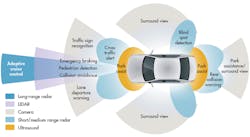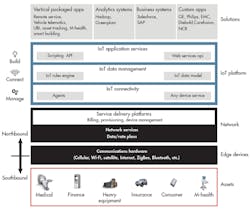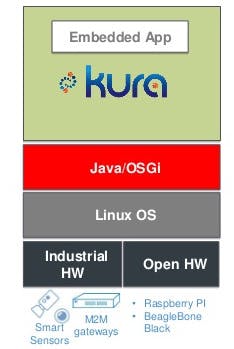Everyone has their own idea of what the Internet of Things (IoT) is, but one thing we can all agree on is this: It is here to stay whether we like it or not. The challenge will be living with the plethora of devices that will be connected in some fashion.
This file type includes high resolution graphics and schematics when applicable.
The smartphone provides the ultimate mobile hook into the cloud/Internet. It is considered an IoT device because it not only provides a way to view information from the cloud, but is also a major source of information about the phone’s owner. The phone has a collection of sensors that can provide details about location, movement, and use and quite a bit of that is going to the cloud where “big data” analysis is putting it to use.
This information is often used to provide targeted advertisements and this only gets more effective, or invasive depending on your perspective, as the surrounding electronic landscape gets populated with even more IoT devices. These devices may not be connected to each other directly, but often the data they generate is correlated via big data analysis.
The IoT Car
Automotive solutions highlight integrated IoT growth with the amount of sensor information growing by leaps and bounds. Even tire-pressure sensors are part of the mix (see “Tire-Pressure Monitoring Pumps Up Performance” on electronicdesign.com). These wireless sensors, which are found on all new vehicles, can pinpoint a leak or let a driver know if the tire pressure is too low.
An Advanced Driver Assistance Systems (ADAS) utilizes an array of sensors generating immense amounts of information that can be processed and sent to the cloud (Fig. 1). The sensors include ultrasound and surround-view cameras for locating nearby obstacles for parking-assist operations. Short-, medium-, and long-range radar can be used for features like adaptive cruise control and emergency braking. Cameras can be used for traffic sign recognition. GPS provides location information, while hooks into the speedometer can provide information for tracking traffic patterns.
Of course, this information can also be used for other purposes, such as locating the nearest gas station or a store with a sale on a driver’s favorite purchases. There are even dongles from insurance companies that plug in to capture braking and acceleration data among other information.
Telematics, ADAS, and engine control are only part of the story when it comes to the connected vehicle. That ever-present display is providing more information to the driver, and the system is often hooked into more IoT devices like smartphones. They already provide navigation, multimedia capabilities, and smartphone connectivity as well as controlling and monitoring the entire car. That alone makes the automotive platform a significant IoT environment but that is just the beginning.
Trucks such as Ford’s F-150 (Fig. 2) can link with a host of IoT devices, such as tools that can allow a user or company to track when devices are loaded in the vehicle. Such a system can track when vehicles are used at a job site employing the same wireless location approach used for key fobs that unlock a car door when the user with the fob is outside the door and pulling on the handle.
Automotive platforms are just one example of how IoT systems can work. The home is another environment where the technology is proliferating. Even light bulbs like Sengled’s Pulse Solo (see “IoT Is Here Whether You Like It or Not” on electronicdesign.com). The Pulse Solo is an LED lightbulb with a built-in, wireless amplifier and speaker system. A smartphone can stream audio to the Pulse Solo using Bluetooth.
The view of IoT thus far glosses over the communication and security challenges. Many devices will connect directly to the Internet, but others will communicate locally or through gateways. The use of standard protocols like TCP/IP allows traffic to move across standard routing systems, while it is the higher-level protocols that allow the interchange of data. This level is where there are fewer standards.
IoT Communication Frameworks
The lack of high-level standards has not prevented a vast array of IoT frameworks from emerging.
Wind River’s Edge Management System (EMS) is designed to address the array of services needed to deploy and manage sophisticated IoT environments (Fig. 3). It targets IoT devices such as those used in medical applications. An agent runs on the device. This supports the various services from control and monitoring to provisioning and remote updates.
To simplify programming, the system supports a rule system and data model that maps a consistent interface onto the agent. Developers dealing with data from and control of IoT devices can utilize this vendor-specific API to handle the remote agents. Details of communication, connectivity, and security can be ignored when dealing with the content. Of course, the system deals with these details and others can address this management using other tools within the framework.
Wind River’s EMS is only one of many solutions available to developers. In general, the frameworks have a similar architecture with an agent that runs on the device. The frameworks and their protocols are built on top of communication standards such as TCP/IP, allowing the frameworks to take advantage of standard communication interfaces like WiFi and Bluetooth.
EMS is integrated with Wind River’s application development support. It can handle end-to-end security strategies that are customizable and is designed for large-scale IoT deployments.
Gateways that can provide additional services are typically defined within the framework. They can usually run applications that provide translation, correlation, and local management and are often firewalls between a network of IoT devices and the cloud.
It is possible to create an IoT device without utilizing a framework, but it takes a significant amount of work to match the range of services provided by a framework. Keep in mind that these frameworks do not just involve moving data from the IoT device to the cloud. Distribution of data, security, and a host of other details need to be managed as well. For example, some frameworks provide a publish/subscribe infrastructure that allows data to be shared with any number of devices within the environment. These may be peers, gateways, or servers running applications that also run on the framework. Data generated by IoT devices may wind up in SQL databases in the cloud or big data databases. In general, the agents on the IoT devices do not have to deal with details of where the data it generates is going.
There are open-source solutions in this space and some vendors are basing their frameworks on them. Note that this is not the same thing as having an IoT framework that is built on open-source or standard APIs. Those are typically interfaces and protocols that provide the communication between nodes within an IoT framework and almost all IoT frameworks use these. The open-source IoT frameworks open the APIs used within the framework.
Kura is an open-source IoT framework hosted by the Eclipse Foundation (see “Developers Discuss IoT Security and Platforms Trends” on electronicdesign.com). Kura is built on a Java/OSGi framework (Fig 4.). It uses MQTT to exchange data. MQTT can run over protocols like TCP/IP. Kura agents and gateways can run on low-end platforms like Raspberry Pi or the Beaglebone Black.
There are complementary projects to Kura like Mihini, a high-level, Lua API for machine-to-machine (M2M) applications. (The term “M2M” is gradually being overtaken by IoT.) Mihini is designed for microcontrollers with a few megabytes of storage, so it does not necessarily target the very low end of the IoT spectrum.
Fusing Sensors
Sensor fusion is often associated with IoT devices that provide additional context-related data by combining information from other local sensors. This fused data essentially implements a virtual sensor. Platforms such as smartphones often have sufficient resources to utilize sensor data directly using native applications. Other platforms may just move this information up the food chain. The virtual sensor information is often much more compact in terms of data compared to the sensor data that is used to generate it. For example, a virtual sensor that indicates where the device is and how it is moving can prove useful. Some sensor fusion technology can currently indicate whether the device is moving on a train or in a car.
Sensor fusion hubs are a popular means of integrating sensor hardware. The microcontrollers in the hub handle the integration of data, providing it and virtual sensor information to the local host. In many cases, these can be viewed as IoT devices.
The idea of analyzing data from multiple sources is not restricted to sensor fusion hubs. The approach is applicable to combining data from IoT devices as well. Analysis of big data is simply the other end of the spectrum.
This file type includes high resolution graphics and schematics when applicable.
Hardware and software make IoT possible, but many of the costs of using these devices will remain hidden from users. Not all connectivity is free. Most data will not be under the direct control of users. Security of these systems is another area of concern because they greatly increase the attack surface of a user's electronic environment. There are also some concerns about the legitimate, or at least legal, use of this information.
There are many opportunities and advantages of IoT as well. In any case, IoT is here to stay, whether we like it or not.
About the Author
William G. Wong
Senior Content Director - Electronic Design and Microwaves & RF
I am Editor of Electronic Design focusing on embedded, software, and systems. As Senior Content Director, I also manage Microwaves & RF and I work with a great team of editors to provide engineers, programmers, developers and technical managers with interesting and useful articles and videos on a regular basis. Check out our free newsletters to see the latest content.
You can send press releases for new products for possible coverage on the website. I am also interested in receiving contributed articles for publishing on our website. Use our template and send to me along with a signed release form.
Check out my blog, AltEmbedded on Electronic Design, as well as his latest articles on this site that are listed below.
You can visit my social media via these links:
- AltEmbedded on Electronic Design
- Bill Wong on Facebook
- @AltEmbedded on Twitter
- Bill Wong on LinkedIn
I earned a Bachelor of Electrical Engineering at the Georgia Institute of Technology and a Masters in Computer Science from Rutgers University. I still do a bit of programming using everything from C and C++ to Rust and Ada/SPARK. I do a bit of PHP programming for Drupal websites. I have posted a few Drupal modules.
I still get a hand on software and electronic hardware. Some of this can be found on our Kit Close-Up video series. You can also see me on many of our TechXchange Talk videos. I am interested in a range of projects from robotics to artificial intelligence.






